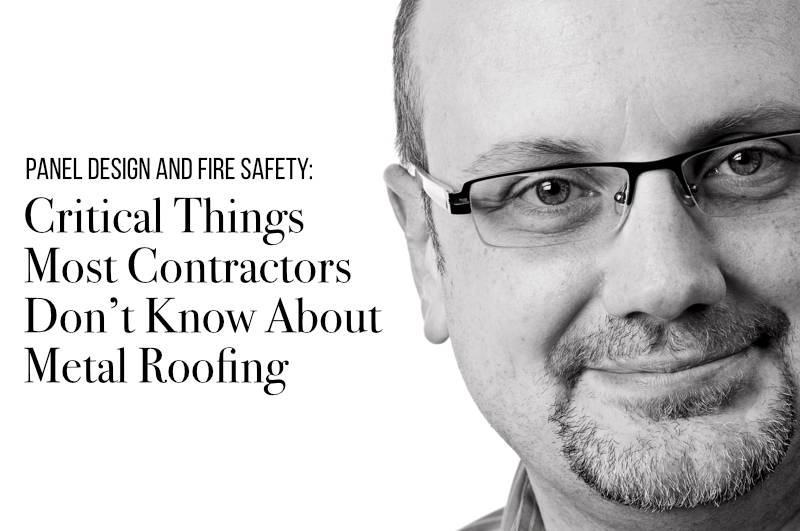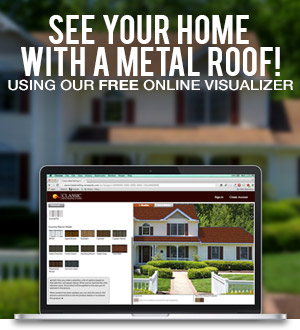2 Critical Things Most Contractors Don’t Know About Metal Roofing: Panel Design and Fire Safety
May 24, 2019 | Filed under: Buying a New Roof,Newsletter Articles,Research

We continue our series of 10 Critical Things That Most Contractors Don’t Know About Metal Roofing. This post is a special message from Todd Miller, Roofing Expert and President of Classic Metal Roofing Systems.
”Which is better? A shingle roof or a metal roof?” It depends…
Someone asked the other day, “Which is better – a shingle roof or a metal roof?” I had to answer with, “It really depends on what you want to accomplish.” In some cases, folks are looking for short-term cost-effectiveness, and in other cases, they are seeking longer-term value and benefits. Our free online Roofing Needs Profiler is a great way to determine what sort of roof best meets the needs of you and your home.
All-too-frequently, I hear stories of homeowners who had metal roofs installed, but in the end, were upset and frustrated with a roof that did not perform as they expected. When I explore these situations, I often find critical considerations particular to metal roofing that the contractor simply was not aware of.
Let’s look at 2 more of those critical things: Panel Design and Fire Safety.
1. METAL ROOFING PANEL DESIGN
There are many good metal roof panel designs available today, from various styles of vertical seams to the more interesting “modular” panels designed to look like standard shingles, wood shakes, slate, or even southwest barrel tile.
Contrary to what many folks believe, panel design does impact the expected performance of a metal roof, and there are two key areas of consideration:
- Do the panels actually interlock one to the next on all four sides, or do they just overlap on two or more sides? Interlocking panels have greater security as there is no opportunity for debris to enter the overlaps over time, causing them to swell or “open up,” allowing water and wind infiltration. Many “entry level” metal roofs such as corrugated products and simple batten or deck-mounted metal shingles do not feature full interlocks. The premium products will feature full interlocks, requiring more intricate manufacturing techniques.
- How do the panels and the fasteners allow for the metal’s expansion and contraction? Except in the case of some tile-look panels with horizontal “folds” or “breaks” in the metal that allow for expansion and contraction, exposed fastener panels do not have adequate allowance for the metal to expand and contract with temperature changes. Therefore, the fasteners will loosen over time and need to be re-tightened usually after 5 – 7 years and replaced with larger diameter screws by year 15. When the fasteners are loose (and also as the rubber washers on the screws age), water tends to work in around the fasteners, causing the metal to rust and the underlying wood to rot. Concealed fastened panels have a variety of ways in which they allow for the metal’s movement, including clip-fastening and slotted fastener holes. Smaller modular metal roofing panels have full interlocks between the panels to allow for the metal’s thermal movement.
Panel Design is one key area where, despite what many consumers and even contractors think, metal roofs are not all the same. Things like exposed fasteners and panel overlaps are indicators of “entry level” products that leave a home vulnerable in crucial areas.
2. METAL ROOFING FIRE SAFETY
Misinformation is prevalent when it comes to fire safety and ratings of virtually all types of roofs. Metal roofs are recognized for the fact that airborne sparks or brands do not readily ignite on them. They are also recognized for their low weight that does not pose a significant cave-in threat in the event of a fire inside the home.
- The actual fire classification of most roofs is based upon assembly testing. Things like fire-resistant underlayments and noncombustible roof decks contribute to how a roof system is rated. Many products depend upon the ratings of other materials in the roof assembly for their final rating because that provides contractors and homeowners with a wider range of options rather than be locked into one particular assembly to achieve a specific rating.
- Over the years, Class A rated roofs, and roof assemblies have sometimes had fingers pointed at them for “containing” fires in the structure’s attic rather than allowing the flames to burn vertically through the roof and self-vent. Firefighters generally are trained on how to “open up” roofs to prevent this.
Additionally, a fire-resistant roof made of aluminum with a lower melting point than steel may be advisable in some situations.
DESIGNED FOR PROTECTION
When you purchase a Classic Metal Roofing System, we have taken full advantage of hidden fasteners and fully interlocking panel designs to deliver the best possible roof that meets and often exceeds your requirements for protection from rain, wind, and even fire.
As always, I hope that our information is helpful and we encourage you to contact our team of metal roofing experts at 1-800-543-8938 or send me an email, whenever we can answer any questions you may have.
